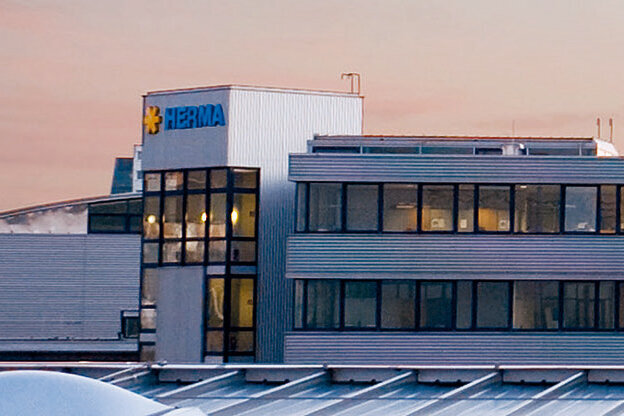The history from the foundation 1906 to today
1906 - 1938
1906
Heinrich Hermann, born in Stuttgart in 1876, founder of HERMA, father and devout Christian, was an entrepreneur with heart and soul. Endowed with visionary flair, not afraid of hard work and prepared to take risks. It is Heinrich Hermann to whom we today at HERMA owe our thanks.

1906
“I sold the first labels in early February to Daimler,” reported founder Heinrich Hermann (shown here with his wife Christine) in his account of how it all began. In 1906, at age 30, Hermann established an independent business with two printing associates. Perceiving that the growing supply of industrially produced goods required new means of identification and labelling, he saw a big future in the manufacture of embossed labels and merchandise tags.
1910
Seal tags and sausage rings were added to the product range. The young company started on a path to success. The workshop soon became two small for the employees, now 29 in number, so a new building was erected in Ulmer Strasse 300. Its proud sign read “Hch. Hermann, Label Factory and Printers”.
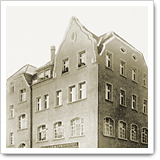
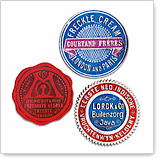
1913
Embossed labels sold well throughout Europe. In England the company opened its first branch office abroad.
1914-1924
When the First World War broke out, the company was put to a severe test. Heinrich Hermann was inducted into service in 1915, and his wife Christine took over business operations. Articles for the army postal service were added to the product range. In spite of many difficulties it was possible to keep the company going. After the war it was restructured, and as a part of this its first trademark came into being: a signet with a sailing ship.
In the inflation years, which put a heavy strain on the national economy, the company experienced a marked expansion thanks to new product ideas like quick moisteners, needle labels and adhesive rolls. Many of these products were manufactured using machines which the company itself designed and built. Thus it gathered engineering know-how as it grew.
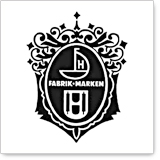
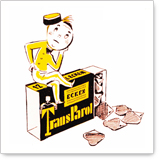
1926
A new hobby, photography, became generally popular. With Transparol photo corners, which were almost invisible, Hermann took a great leap forward that was destined to drive the company’s growth for many years. By 1935 this product accounted for half of the company’s sales.
1928
Hermann, the company patriarch and a Protestant in the Württemberg tradition, established a support fund to “provide financial aid to all employees who as a consequence of illness, age, disability or accident suffered economic distress”. This was by no means usual for a company with barely 120 employees. Hermann’s social commitment extended well beyond financial help. In the late 1920s, he relentlessly pressured the authorities to build a day nursery in Wangen. It exists to this day.
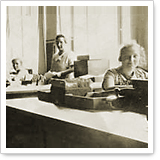
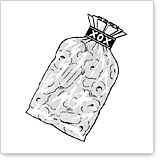
1929
Clipfix, a novel package closure made of paper, brought the company increased sales.
1939 - 1969
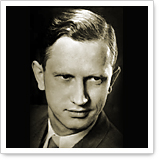
1939-1950
Heinrich Hermann died shortly after the outbreak of the Second World War. His oldest son Eberhard, who had been chosen to succeed him, died in combat in East Prussia. The two younger sons were taken prisoner of war. As a consequence, their mother, Christine Hermann, took charge of the company as she had done during the First World War. The company’s buildings and machinery survived the war without significant damage. In late 1945 Werner Hermann (left) returned from captivity and became sole manager. His brother Heinrich Hermann Jr. (right) joined him starting in 1953. At the end of the war, just under 60 employees of the originally roughly 200 employees were still on hand. After the currency reform in 1948, demand started to grow again and the company’s workforce grew to more than 200.
1951 and later
Inspired by the new supermarkets in the USA, the Heinrich Hermann Papierwarenfabrik (Heinrich Hermann Stationery Products Factory) developed a special process for coating adhesive paper and marketed self-adhesive labels under the arco brand. It was the first company in Germany to offer such a product. These small, self-sticking price labels set the stage for the triumphant rise of self-service stores. They were the second product, after Transparol, to give the development of the company a decisive boost. By 1953 it had 400 employees and almost 100 home workers – more than ever before.
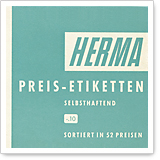
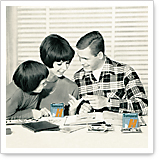
1955
An adhesive coating developed in the company’s own laboratory made it possible to manufacture self-adhesive photo corners as well. The Transparol brand, already well known, soon became a huge success in Germany, the Benelux countries, Spain, Italy and Austria.
Ab 1956
The company celebrated its 50th anniversary. And because its innovative adhesive labels were gaining an increasing market share, it used its engineering know-how to develop special label dispensers. The first devices, Model A and Model C, were designed only for manual operation. In 1960 the first electric labelling machine, the Model F, was presented. This was the “grandfather” of the modern HERMA labelling machines. What made it special was a built-in heating unit that permitted removal of the labels. The films and paper backings used at that time did not permit separation in any other way.
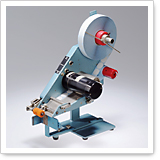
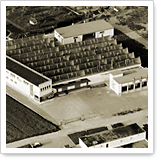
1961
In Bonlanden HERMA held the topping-out ceremony for a new coating plant; its production facilities in Wangen were no longer suitable. In the decades to follow this location continued to expand.
1963
A new trend appeared: computers. And labels to go with them.
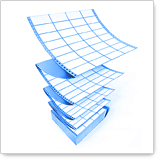
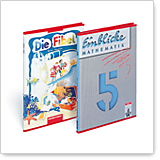
1964
HERMA purchased the REX company in St. Andreasberg/Harz. From that time on, the popular book covers with the distinctive red tape on the edges were a HERMA brand. To date, more than 200 million have been sold.
1965
The “HERMA with star” trademark was introduced for products with an adhesive coating. Increasingly, customers used the word HERMA when referring to the Heinrich Hermann Papierwarenfabrik, which was still the company’s official name. In mid-1969 HERMA officially became the name for the whole company.

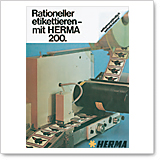
1968
The HERMA 200 labeller was introduced. Thanks to its modular design, customers were able to adapt it their individual needs.
1969-1973
Self-adhesive labels became a part of everyday life. They accounted for some 90 percent of HERMA’s total sales. To meet the growing demand, two new label manufacturing plants were established in Deizisau and Filderstadt-Bonlanden.
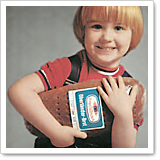
1970 - 1999
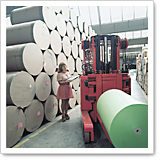
Early 1970s
The company, which had been organised thus far according to strictly functional principles, was restructured along three product lines for better alignment with the markets: adhesives, labelling systems and stationery products. Such an organisational form had never been tried with a family-owned company of this size. Thanks to their different customer structures, the three divisions complemented one another well, which helped to overcome temporary difficulties in the market. As a result, HERMA continued to grow at a steady rate, even when the economy was weak. The share of exports also increased year by year.
1971-1978
Starting in 1971, there had been increased efforts to internationalise the company, leading to the founding of the subsidiary HERMA France. In 1978 separate subsidiaries were established in Austria and Belgium.
1976
Heinrich Herrmann retired. His successor, Werner Röhm (centre), was an outside manager and friend of the family. Röhm and Werner Herrmann (right) initially managed HERMA jointly. During its 30 years under Röhm’s leadership, the renowned Stuttgart company grew to become an enterprise with a global reach and unsurpassed expertise in self-adhesive technology.
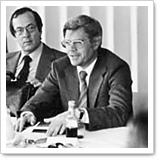
1982
Werner Hermann gave up his operative responsibilities. Werner Röhm became sole managing director and established a permanent management group for participation in all major decision making. Already in the late 1970s, HERMA had been transformed into a GmbH & Co. KG (company with limited liability as general partner).
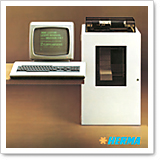
1985-1987
PCs and laser copiers entered the office environment. With its ESC 12/18 labelling machine (photo) HERMA accelerated the processing and printing of data on labels. HERMA Laser-print made it possible to print labels quickly and efficiently.
1989
The building in Deizisau, which had been erected in 1971, was expanded, giving it its present-day appearance.
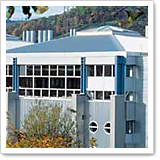
1991
HERMA founds a subsidiary in Haverhill in the United Kingdom for the construction and sale of labelling machines. In 2000, a cutting centre for adhesive material, amongst other facilities, is founded in Newbury. The two units are then combined to create the subsidiary HERMA UK.
1992-1994
HERMA set forth binding company mission statements. At that time, this was not even customary in major corporations. In 1994 all lines of business were certified to DIN EN ISO 9001.
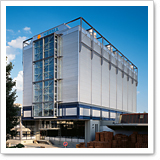
1993
After almost three years of construction HERMA dedicates one of Europe's most modern bulk warehouses for the Adhesives Division in Filderstadt-Bonlanden.
1995
HERMA extended its leadership position as an innovator. It was the first manufacturer of adhesive coatings to use UV acrylic adhesives. The company came up with innovative solutions for applying labels to difficult substrates, and it devised labelling methods for extreme conditions, including labelling of hazardous materials, very hot chemical barrels and containers that come into contact with seawater.
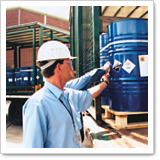
1998
Commercial transparency is becoming increasingly important for growing medium-sized companies. For this reason HERMA introduces SAP. It becomes a project requiring large investments and substantial effort from the staff, but the new opportunities for transparent, sustainable cost calculations and planning are soon worth it.

1999
HERMA was the first company in the industry to use a curtain coater. This marked a quantum leap in manufacturing speed and put HERMA on the map as a technology leader.
2000 - 2007
2001
To ensure continued independent development, HERMA chose the legal form that it has today. Shareholders’ interests were represented in HERMA-Holding GmbH + Co KG, and HERMA GmbH, a wholly owned subsidiary, took responsibility for operational activities.
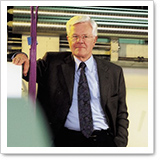
2003
Following the long-term plan, Werner Röhm steps down from operational management of the company at the end of 2003 after 30 years in managerial positions and becomes chairman of the company advisory board. Thanks to the management board established by Werner Röhm, a high level of continuity is ensured even in the event of leadership changes. Dr. Rüdiger Pantzer and Manfred Minich take over the leadership of the company as managing directors. The authorized officers Thomas Thumm and Sven Schneller also belong to the management board at this time.
2003
The new HERMA 400 labelling machine set international standards. With its integrated control system, it no longer required a large control cabinet. Moreover, the basic unit could be manufactured in large quantities. The modular system made it adaptable to a wide range of customer needs and permitted easy integration with existing equipment. Today it is the world’s most compact labelling machine in this performance class.
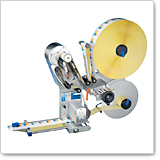

2004
HERMA Benelux was founded in the Netherlands. In addition, a new logistics centre with state-of-the-art technology was opened in Filderstadt. In the past, 1,000 packages had been dispatched each day, and now it became possible to send 1,200 packages per hour. Goods could be made ready for dispatch within 15 minutes of the receipt of an order.
2005
Managing director Dr. Rüdiger Pantzer, who also led the Adhesives Division for 20 years, leaves the company mid-year due to age. He is succeeded by Dr. Thomas Baumgärtner, who has been preparing for his new role since the beginning of the year.
On the occasion of a factory visit from the Minister of the Economy and Deputy Minister President of Baden-Württemberg, Ernst Pfister, HERMA announces another major investment at the Filderstadt location: Arguably the most advanced coating facility in the world is to be built there.
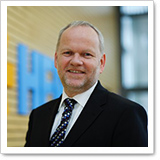
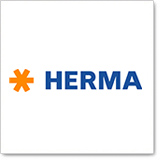
2005
In the past the divisions largely cultivated their images independently of one another, but now the first comprehensive corporate design for the company and its subsidiaries has been created. It focuses on cultivating a more emotional, yet unmistakable appeal to all target groups. The logo is also updated at the same time.
2005
HERMA broke new ground with the Commerce Connector. Customers were now able to shop via the HERMA Web site, which connected them to retailers. This underlined the company’s leading role in e-commerce in the stationary and office supply sector.
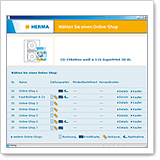
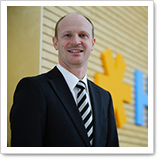
2006
HERMA celebrated its 100th anniversary. The motto for this occasion expressed the company’s optimism: “100 years of HERMA. And many more to come.” To make better use of synergy effects it restructured its divisions: Adhesives, Labels, and Labelling Machines. With a workforce of approx. 800, the company achieved annual sales of 200 million euros. Late in the year, the advisory council of HERMA GmbH appointed Sven Schneller to the position of managing director. At the same time Schneller became spokesman for the management board.
2007
HERMA LabelAssistant online won the innovation prize, software category, of the German Initiative Mittelstand (Small and Medium-Sized Enterprise Initiative), which is backed by the Federal Ministry of Economics and Technology. This free Web tool allowed users to design labels directly via the Internet and print them in the office or at home. Two years later the e-commerce package won the prize in its category. This free shop-in-shop solution, which was integrated into retailer Web sites, included several modules, including online label design tools, product finders, animated product presentations and prize competitions. It offered added value to customers and the opportunity to make quick online purchases.

2008 - 2014
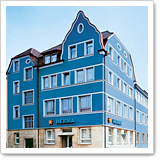
2008
HERMA GmbH said good-bye to its birthplace, the production plant on Ulmer Strasse in Wangen. The labelling machines division had shown above-average growth, and there was no space left for expansion of the facilities and hiring of new personnel. Thus the entire division was relocated to Deizisau, where one of the world’s most modern and efficient production lines for labelling machines was set up. At the same time the labels division, which had been split into three locations, was brought together in Filderstadt.
2008
In Filderstadt HERMA inaugurated the world’s most modern coating facility in the presence of Minister President Günther Oettinger (centre). Through this expansion the company tripled its production capacity for adhesives, from some 250 million square metres to 750 million square metres per year. This was made possible by production speeds of 1,100 metres and more per minute. The plant implemented a shortest-route concept for the internal flow of materials that was unique in the industry. The first stage required an expenditure of 30 million euros, which was the biggest single investment in the company’s history.
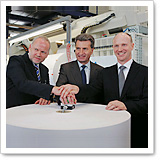
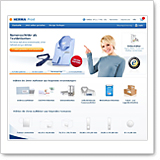
2010
HERMA launched an online service called HERMA Print that allowed users to design their own labels and stickers and to print them quickly at low cost. This service also included complex functions like saving of templates and mail merge options. In designing the user interface HERMA drew on its experience with the prizewinning LabelAssistant online, which set industry standards with its clear layout and well-conceived functions.
2011
HERMA again invests some ten million euros in its Filderstadt production plant for adhesives. A section of the building is built to accommodate a new fully automatic packaging facility. Two cutting machines are also part of the investment package.
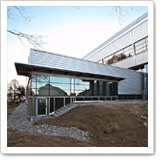

2012
Martin Kühl becomes head of the Labelling Machines Division and is appointed to the management board in the following year.
Fritz-Jürgen Heckmann takes over as chairman of the company advisory board from Werner Röhm.
2012
Under the name HERMA 2020 the company develops a uniform strategy for the whole group with clear requirements and goals for all three divisions and the subsidiaries.
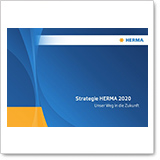
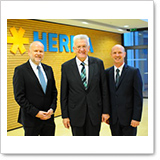
2013
On a visit to the HERMA plant, Minister President of Baden-Württemberg Winfried Kretschmann learns about innovative production processes in self-adhesive technology and the challenges facing a highly specialized, export-oriented, medium-sized company committed to manufacturing in Germany.
2014
HERMA expands its administrative building at its headquarters in Filderstadt-Bonlanden to include a two-storey building on the roof of the production plant. New offices for approximately 60 employees are created in the 1,500-square-metre building. The investment totals 3.5 million euros.
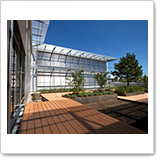
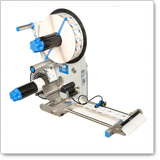
2014
HERMA basic debuts at Interpack. Supplementing HERMA 400, it provides a completely new label applicator series for reliable and economical labelling solutions. The new label applicator allows even users who were previously excluded for reasons of cost, such as users in developing economies, to begin using leading HERMA technology.
2014
HERMA opens its first online shop at www.herma-etikettenshop.de. Its focus is on labels for industrial and logistics purposes. The Labelling Machines Division soon follows suit at www.herma-components.com and the Adhesives Division also opens its own online shop. The company builds on its experience with e-commerce which it has been gaining since 2010 with HERMA Print.
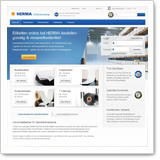
2015 - today
2015
HERMA succeeds in acquiring an 80,000-square-metre property for expansion directly adjacent to its headquarters in Filderstadt. The master plan envisions that all three divisions will be located at this site in the future.
2016
HERMA announces the largest investment in the company's history: For around 100 million euros, another completely new coating plant for adhesives and the most advanced production lines in the world for label applicators and labelling machines are to be built on the new campus by 2019. The first preparations for the new buildings begin in early 2016.
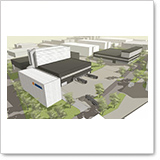

2016
After Thomas Thumm reaches the maximum age for management participation, the current management board is composed of managing directors Dr. Thomas Baumgärtner (on left) and Sven Schneller (second from left) as well as Martin Kühl (second from right) and Mario Zirn.
2016
HERMA founds a subsidiary in Fairfield, NJ, USA. It focuses on sales and service for label applicators and labelling machines.
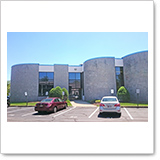

2016
The Labelling Machines division of HERMA UK celebrates its 25th anniversary. It has become an industry-leading company in the UK – and continues to see great growth potential. Production capacities are now being expanded by more than 30 percent with major investments in production.
2017
HERMA has already been able to make many production processes even more efficient in recent years with the “Total Productive Management” approach, or TPM for short. The findings are now being adapted and used effectively for office workplaces.
“Werkdrei” goes on stream. This "innovation engine" has been created by a team of employees who, aside from their existing business activities, are engaged in new business models, primarily using agile methods and tools. The team members rotate regularly to bring experience to their respective areas.

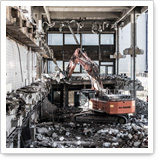
2017
Spectacular demolition work is taking place on the newly acquired company premises opposite HERMA’s headquarters. The site will then be prepared for the new buildings for the Self-adhesive Materials and Labelling Machines division.
2018
In Filderstadt, the year is all about construction activities on the new HERMA site. Numerous huge cranes and large construction vehicles form an impressive building ballet at times.

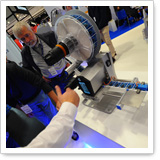
2018
World première in Nuremberg and Birmingham: the new HERMA 500 label applicator is presented for the first time at the Fachpack and PPMA trade fairs. It is unique worldwide in terms of connectivity, flexibility, usability and performance. Its predecessor, the HERMA 400, has already been sold more than 40,000 times – a world record in this performance class.
2019
The HERMA Labelling Machines division moves from Deizisau to Filderstadt. It starts production there in its completely new plant. From the very beginning, this plant was specifically designed to meet the material flow and production requirements for label applicators and labelling machines. This enables HERMA to concentrate all three business divisions in a single location: the entire chain of self-adhesive technology know-how in a competence centre – this is unique worldwide.
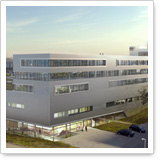
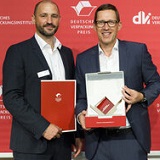
2019
The HERMA InNo-Liner system receives the German Packaging Award in the sustainability category. It enables the use of logistics and shipping labels without any supporting material, thus saving thousands of tonnes of paper.
2020
The new coating plant for self-adhesive materials is put into operation. The €90 million investment in Filderstadt has a driverless transport system, state-of-the-art packing robots and a pioneering energy concept. With the so-called plant 2, HERMA is increasing its annual self-adhesive material capacity by 50 percent to 1.2 billion square metres – an area as large as New York City.
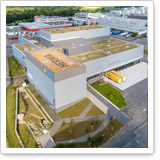
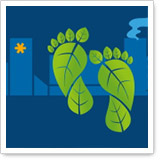
2021
From the beginning of 2021, the company will finance climate protection projects in Filderstadt in the amount of the calculated emissions, thus making a valuable contribution to climate protection.
2021
The founder of HERMA, Heinrich Hermann, is posthumously honoured at the beginning of the year: a section of the former Fabrikstraße in Filderstadt, where the company's headquarters are located, is rededicated as Heinrich-Hermann-Straße.
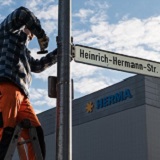
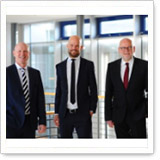
2021
There is also a sustainable change in the management of the company in 2021. Dr. Thomas Baumgärtner, Managing Director and Head of the Self-adhesive Materials Division, will retire in March after a 16-year history of growth and success at HERMA. His successor will be Dr. Guido Spachtholz (centre) who also has a PhD in Engineering.
2022
HERMA increasingly sees sustainable action as a strategic corporate task. The target for 2040 is therefore carbon neutrality, also taking into account indirect emissions and by offsetting unavoidable emissions. Moreover, the company is creating the position of Chief Sustainability Officer (CSO) and the area of sustainability management for the first time. The first CSO will be Marcus Gablowski.
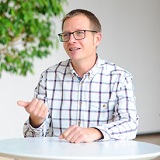
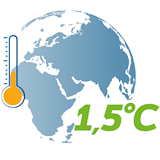
2023
HERMA participates in the globally active Science Based Target Initiative (SBTi). On the basis of science-based climate targets, companies in the SBTi commit to voluntarily taking measures that are actually necessary to limit the further increase in global warming to 1.5 degrees Celsius by 2100. We are therefore committed to the 1.5 degree Celsius target.
2024
For the first time, HERMA is providing transparent and detailed information in a sustainability report on how it intends to achieve its sustainability goals and what progress has already been made in this area and is being targeted. It relates to the 2022 financial year and was prepared in accordance with the globally applicable standards of the Global Reporting Initiative (GRI).
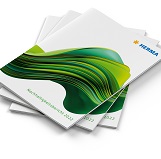
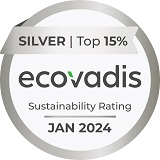
2024
Despite some of the more stringent criteria, HERMA has once again achieved a silver medal in the EcoVadis sustainability audit. In relative terms, we have even improved significantly: whereas HERMA was among the top 20 per cent of companies audited by EcoVadis last time, we have now even managed to make the leap into the top 12 per cent. To receive a silver medal, companies must be among the top 15 per cent for the first time. Previously, the threshold was 25 per cent.
2024
HERMA is installing its own photovoltaic system on the roof of Plant 2.
Around 100 electric cars could each drive 30,000 kilometers a year using the green electricity generated by this system.
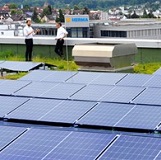

2024
The renowned Science Based Target Initiative (SBTi) officially confirms the end of 2024:
HERMA is doing its part within its direct sphere of influence to ensure that the important 1.5-degree climate target can continue to be achieved.
To this end, HERMA is reducing its own absolute greenhouse gas emissions by 42 percent by 2030 - relative to the base year 2021.
2025
HERMA has been awarded a gold medal for the first time in the EcoVadis sustainability audit. This puts the company among the top 5 percent of companies audited by EcoVadis in the last 12 months.

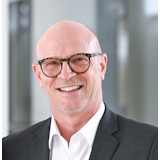
2025
Long-standing managing director Sven Schneller has announced his retirement from the company in mid-2026. He will then have worked for HERMA for a total of 40 years, 20 of them as managing director.
2025
With the aim of ensuring long-term continuity, the advisory board has appointed HERMA CFO Oguzhan Celil as managing director alongside the two existing managing directors, Sven Schneller and Dr. Guido Spachtholz, with effect from August 1, 2025. He has been a member of the HERMA management team since mid-2021. Martin Kühl, head of the labeling machines division, has been a further member of the management team since 2013.

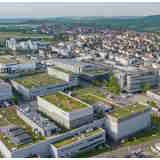
2025
For the first time, the entire HERMA headquarters — including all three business units — has been certified by TÜV Süd for its environmental management system in accordance with the internationally recognized ISO 14001 standard. This marks another important step on our path toward becoming a consistently sustainable company.
